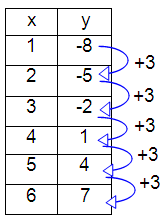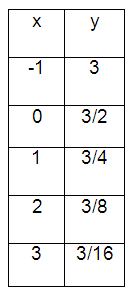FROM THE TABLE OF VALUES CHECK THE FUNCTION IS EXPONENTIAL OR LINEAR
Subscribe to our ▶️ YouTube channel 🔴 for the latest videos, updates, and tips.
Linear function :
In linear relationship, the change will be equal and constant. To get every y-value, we have to add or subtract some constant.
Exponential function :
In exponential relationship, the change will be equal and constant. To get every y-value, we have to multiply or divide some constant.

Tell whether the table of values
represents a linear, or an exponential function.
Problem 1 :

Solution :

To get values of y, we have to subtract 3. So, it is linear function.
Problem 2 :

Solution :
By observing the values of y, 1/18 should be multiplied by 6 to get 1/3
(1/3) ⋅ 6 = 2
2 ⋅ 6 = 12
12 ⋅ 6 = 72
Every time, every values of y is multiplied by 6 to get the next value. So, it is exponential function.
Problem 3 :

Solution :

By observing the values of y, 8 should be divided by 2 to get 4.
8/2 = 4
4/2 = 2
2/2 = 1
1/2 = 0.5
0.5/2 = 0.25
So, it is exponential function.
Problem 4 :

Solution :

To get values of y, we have to subtract 2.
2 - 2 = 0
0 - 2 = -2
-2 - 2 = -4
-4 - 2 = -6
So, it is linear function.
Problem 5 :

Solution :

To get values of y, we have to added 3.
-8 + 3 = -5
-5 + 3 = -2
-2 + 3 = 1
So, it is linear function.
Problem 6 :

Solution :

To get values of y, we have to multiplied 1/2.
3 ⋅ (1/2) = 3/2
(3/2) ⋅ (1/2) = 3/4
(3/4) ⋅ (1/2) = 3/8
So, it is exponential function.
Problem 7 :

Solution :

So, the function is neither.
Problem 8 :

Solution :

To get values of y, we have to added 20.
30 + 20 = 50
50 + 20 = 70
So, it is linear function.
Problem 9 :

Solution :

So, the function is neither.
Subscribe to our ▶️ YouTube channel 🔴 for the latest videos, updates, and tips.
Recent Articles
-
Finding Range of Values Inequality Problems
May 21, 24 08:51 PM
Finding Range of Values Inequality Problems -
Solving Two Step Inequality Word Problems
May 21, 24 08:51 AM
Solving Two Step Inequality Word Problems -
Exponential Function Context and Data Modeling
May 20, 24 10:45 PM
Exponential Function Context and Data Modeling